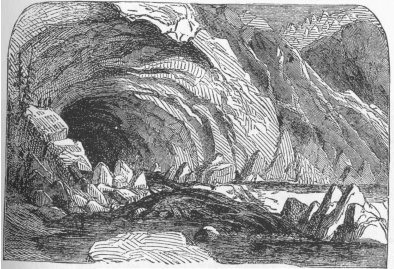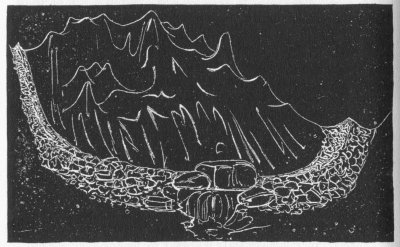
WHAT is a glacier? It is a river of ice, crowded by the weight of mountain-ice down into some valley, along which it descends by a slow, almost imperceptible motion, due to a power of the ice, under the force of gravity, to rearrange its molecules. It is fed by the mountains and melted by the sun.
The glaciers are local in character, and comparatively few in number; they are confined to valleys having some general slope downward. The whole Alpine mass does not move down upon the plain. The movement downward is limited to these glacier-rivers.
The glacier complies with some of the conditions of the problem. We can suppose it capable of taking in its giant paw a mass of rock, and using it as a graver to carve deep grooves in the rock below it; and we can see in it a great agency for breaking up rocks and carrying the detritus down upon the plains. But here the resemblance ends.
That high authority upon this subject, James Geikie, says:
"But we can not fail to remark that, although scratched and polished stones occur not infrequently in the frontal moraines of Alpine glaciers, yet at the same time these moraines do not at all resemble till. The moraine consists for the most part of a confused heap of rough angular stones and blocks, and loose sand and débris; scratched
{p. 18}
stones are decidedly in the minority, and indeed a close search will often fail to show them. Clearly, then, the till is not of the nature of a terminal moraine. Each stone in the 'till' gives evidence of having been subjected to a grinding process. . . .
"We look in vain, however, among the glaciers of the Alps for such a deposit. The scratched stones we may occasionally find, but where is the clay? . . . It is clear that the conditions for the gathering of a stony clay like the I till' do not obtain (as far as we know) among the Alpine glaciers. There is too much water circulating below the ice there to allow any considerable thickness of such a deposit to accumulate."[1]
But it is questionable whether the glaciers do press with a steady force upon the rocks beneath so as to score them. As a rule, the base of the glacier is full of water; rivers flow from under them. The opposite picture, from Professor Winchell's "Sketches of Creation," page 223, does not represent a mass of ice, bugging the rocks, holding in its grasp great gravers of stone with which to cut the face of the rocks into deep grooves, and to deposit an even coating of rounded stones and clay over the face of the earth.
On the contrary, here are only angular masses of rock, and a stream which would certainly wash away any clay which might be formed.
Let Mr. Dawkins state the case:
"The hypothesis upon which the southern extension is founded--that the bowlder-clays have been formed by ice melting on the land--is open to this objection, that no similar clays have been proved to have been so formed, either in the Arctic regions, where the ice-sheet has retreated, or in the districts forsaken by the glaciers in the Alps or Pyrenees, or in any other mountain-chain. . . .
The English bowlder-clays, as a whole, differ from
[1. "The Great Ice Age," pp. 70-72.]
{p. 19}
the moraine profonde in their softness, and the large area which they cover. Strata of bowlder-clay at all comparable to the great clay mantle covering the lower grounds of Britain, north of the Thames, are conspicuous by their absence from the glaciated regions of Central Europe and the Pyrenees, which were not depressed beneath the sea."

A RIVER ISSUING FROM A SWISS GLACIER.
Moreover, the Drift, especially the "till," lies in great continental sheets of clay and gravel, of comparatively uniform thickness. The glaciers could not form such sheets; they deposit their material in long ridges called "terminal moraines."
Agassiz, the great advocate of the ice-origin of the Drift, says:
"All these moraines are the land-marks, so to speak, by which we trace the height and extent, as well as the
[1. Dawkin's "Early Man in Britain," pp. 116, 117.]
{p. 20}
progress and retreat, of glaciers in former times. Suppose, for instance, that a glacier were to disappear entirely. For ages it has been a gigantic ice-raft, receiving all sorts of materials on its surface as it traveled onward, and bearing them along with it; while the hard particles of rocks set in its lower surface have been polishing and fashioning the whole surface over which it extended. As it now melts it drops its various burdens to the ground; bowlders are the milestones marking the different stages of its journey; the terminal and lateral moraines are the frame-work which it erected around itself as it moved forward, and which define its boundaries centuries after it has vanished."[1]

TERMINAL MORAINE.
And Professor Agassiz gives us, on page 307 of the same work, the above representation of a "terminal moraine."
The reader can see at once that these semicircular
[1. "Geological Sketches," p. 308.]
{p. 21}
ridges bear no resemblance whatever to the great drift-deposits of the world, spread out in vast and nearly uniform sheets, without stratification, over hills and plains alike.
And here is another perplexity: It might naturally be supposed that the smoothed, scratched, and smashed appearance of the underlying rocks was due to the rubbing and rolling of the stones under the ice of the glaciers; but, strange to say, we find that--
"The scratched and polished rock-surfaces are by no means confined to till-covered districts. They are met with everywhere and at all levels throughout the country, from the sea-coast up to near the tops of some of our higher mountains. The lower hill-ranges, such as the Sidlaws, the Ochils, the Pentlands, the Kilbarchan and Paisley Hills, and others, exhibit polished and smoothed rock-surfaces on their very crest. Similar markings streak and score the rocks up to a great height in the deep valleys of the Highlands."[1]
We can realize, in our imagination, the glacier of the mountain-valley crushing and marking the bed in which it moves, or even the plain on which it discharges itself; but it is impossible to conceive of a glacier upon the bare top of a mountain, without walls to restrain it or direct its flow, or higher ice accumulations to feed it.
Again:
"If glaciers descended, as they did, on both sides of the great Alpine ranges, then we would expect to find the same results on the plains of Northern Italy that present themselves on the low grounds of Switzerland. But this is not the case. On the plains of Italy there are no traces of the stony clay found in Switzerland and all over Europe. Neither are any of the stones of the drift of Italy scratched or striated."[2]
[1. "The Great Ice Age," p. 73.
2. Ibid., pp. 491, 492.]
{p. 22}
But, strange to say, while, as Geikie admits, no true "till" or Drift is now being formed by or under the glaciers of Switzerland, nevertheless "till" is found in that country disassociated from the glaciers. Geikie says:
"In the low grounds of Switzerland we get a dark, tough clay, packed with scratched and well-rubbed stones, and containing here and there some admixture of sand and irregular beds and patches of earthy gravel. This clay is quite unstratified, and the strata upon which it rests frequently exhibit much confusion, being turned up on end and bent over, exactly as in this country the rocks are sometimes broken and disturbed below till. The whole deposit has experienced much denudation, but even yet it covers considerable areas, and attains a thickness varying from a few feet up to not less than thirty feet in thickness."[1]
Here, then, are the objections to this theory of the glacier-origin of the Drift:
I. The glaciers do not produce striated stones.
II. The glaciers do not produce drift-clay.
III. The glaciers could not have formed continental sheets of "till."
IV. The glaciers could not have existed upon, and consequently could not have striated, the mountain-tops.
V. The glaciers could not have reached to the great plains of the continents far remote from valleys, where we still find the Drift and drift-markings.
VI. The glaciers are limited in number and confined in their operations, and were utterly inadequate to have produced the thousands of square miles of drift-débris which we find enfolding the world.
[1. "The Great Ice Age," p. 373.]
{p. 23}